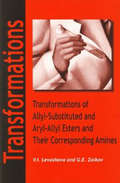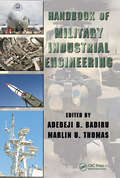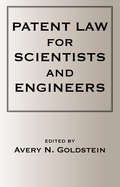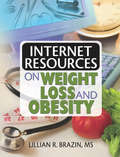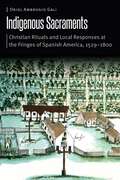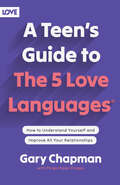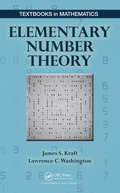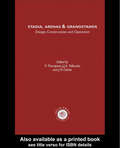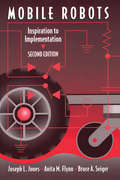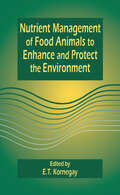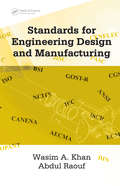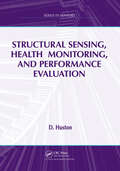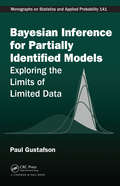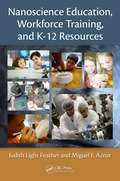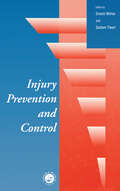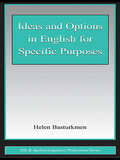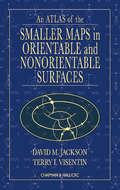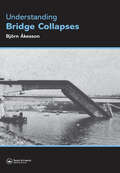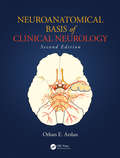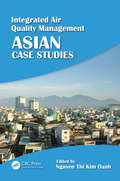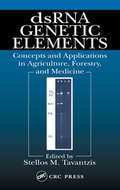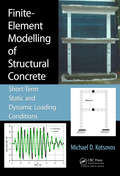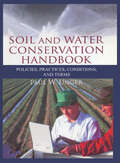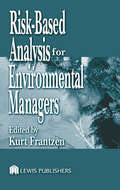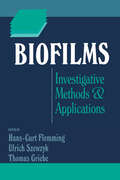- Table View
- List View
Transformations of Allyl-Substituted and Aryl-Allyl Esters and Their Corresponding Amines
by Levashova Gennady ZaikovThe book generally shows the interrelation between allyl unit structure of the initial ester and composition and structure of its products. The first part studies the pathways of chemical regrouping in chlorallylaryl and bisarylallyl esters using quantum-chemical calculations. Energy parameters, structural features and electron structure of interme
Handbook of Military Industrial Engineering (Systems Innovation Book Series)
by Adedeji B. Badiru Marlin U. ThomasIn light of increasing economic and international threats, military operations must be examined with a critical eye in terms of process design, management, improvement, and control. Although the Pentagon and militaries around the world have utilized industrial engineering (IE) concepts to achieve this goal for decades, there has been no single reso
Patent Laws for Scientists and Engineers
by Avery N. GoldsteinAlthough many texts attempt to explain intellectual property law to scientists and engineers, they are ineffective because they fail to present the subject within the proper scope; they are either too expansive or too detailed for the needs of researchers and inventors. Instead of giving a mile-high view of all types of intellectual property or, at
Internet Resources on Weight Loss and Obesity
by Lillian BrazinA seasoned medical librarian provides top Internet resources on health, eating, and nutrition!Obesity has reached epidemic proportions not only in the United States, but also around the world. How does someone with weight loss questions find the most up-to-date information available to make informed health decisions? Internet Resour
Indigenous Sacraments: Christian Rituals and Local Responses at the Fringes of Spanish America, 1529–1800 (Borderlands and Transcultural Studies)
by Oriol Ambrogio GaliIndigenous Sacraments provides the first study of Indigenous perceptions of the Christian sacraments at the fringes of colonial Spanish America, particularly in the missions established by the Jesuits in northwestern Mexico, central southern Chile, and the Gran Chaco. After Jesuit missionaries arrived in these regions between the end of the sixteenth and the early seventeenth centuries, their sacraments came to control every rite of passage, from birth to reaching adulthood to the formation of new families to death. Through the administration of the sacraments, missionaries intended to replace extant Indigenous habits and beliefs with Christian values. The disruptions triggered by such processes raised multiple local reactions, from initial curiosity and incomprehension to rejection, partial acceptance, and ritual imitation. Locals debated the newly introduced rituals and both violently rejected them and developed their own versions, becoming active participants in the sacraments&’ diffusion. Oriol Ambrogio Gali draws on a range of diverse sources to explore the changing attitudes toward the sacraments and to highlight the cultural and religious evolution of the Indigenous groups living at the fringes of Spanish America. By exploring local perceptions of the Christian sacraments, Ambrogio Gali shows that Indigenous peoples were far from static recipients of Christianity in the Americas.
A Teen's Guide to the 5 Love Languages: How to Understand Yourself and Improve All Your Relationships
by Gary ChapmanThe secret to great relationships—just for teens#1 New York Times bestselling book The 5 Love Languages® has sold over 20 million copies, helping countless relationships thrive. Simply put, it works. But do the five love languages work for teens, for their relationships with parents, siblings, friends, teachers, coaches, and significant others? Yes!Introducing A Teen&’s Guide to the 5 Love Languages, the first-ever edition written just to teens, for teens, and with a teen's world in mind. It guides emerging adults in discovering and understanding their own love languages as well as how to best express love to others.This highly practical book will help teens answer questions like:What motivates and inspires me?What does it mean to be a caring friend?What communicates love to my family?What is the best way to get along with the opposite sex?Features include:A straight-forward overview of the 5 love languagesA profile/assessment instrument specifically geared to teensPractical examples/tips for how to apply each language in a teen&’s contextGraphics that drive home key conceptsTeens' relationships matter, and these simple ideas will help them thrive.
Elementary Number Theory
by James S. Kraft Lawrence C. WashingtonElementary Number Theory takes an accessible approach to teaching students about the role of number theory in pure mathematics and its important applications to cryptography and other areas. The first chapter of the book explains how to do proofs and includes a brief discussion of lemmas, propositions, theorems, and corollaries. The core of the tex
Stadia Arenas and Grandstands: Design, Construction and Operation
by P. D. ThompsonThis book covers the International Concrete Society Conference held at the Cardiff International Arena and will be of interest to architects and planners, facility managers and consultants in the fields of engineering, environmental control and services and leisure managemnet, media facilities and to client organizations planning major sports and '
Mobile Robots: Inspiration to Implementation, Second Edition
by Joseph L. Jones Bruce A. Seiger Anita M. FlynnRevised and updated, the second edition includes several new chapters with projects and applications. The authors keep pace with the ever-growing and rapidly expanding field of robotics. The new edition reflects technological developments and includes programs and activities for robot enthusiasts. Using photographs, illustrations, and informative t
Nutrient Management of Food Animals to Enhance and Protect the Environment
by E.T. KornegayNutrient management is an important aspect of feeding livestock and poultry. Today, there is more attention directed toward this issue in animal production than ever before. The heightened awareness of the environmental impacts associated with animal production has caused animal nutritionists to refocus their thoughts, practices, and expectations regarding how nutrients are supplied to animals. In addition, the increase in the size and intensity of modern production units demands new technologies for enhancing nutrient utilization and for reducing the amount of nutrients excreted. Covering these issues and more, Nutrient Management of Food Animals to Enhance and Protect the Environment is a reference tool for agricultural industry leaders, private practitioners, governmental agencies, and researchers.
Standards for Engineering Design and Manufacturing
by Wasim Ahmed Khan S.I. RaoufMost books on standardization describe the impact of ISO and related organizations on many industries. While this is great for managing an organization, it leaves engineers asking questions such aswhat are the effects of standards on my designs? andhow can I use standardization to benefit my work? Standards for Engineering Design and Manuf
Structural Sensing, Health Monitoring, and Performance Evaluation (Series in Sensors)
by D. HustonStructural health monitoring (SHM) uses one or more in situ sensing systems placed in or around a structure, providing real-time evaluation of its performance and ultimately preventing structural failure. Although most commonly used in civil engineering, such as in roads, bridges, and dams, SHM is now finding applications in other engineering envir
Bayesian Inference for Partially Identified Models: Exploring the Limits of Limited Data (Chapman & Hall/CRC Monographs on Statistics and Applied Probability)
by Paul GustafsonBayesian Inference for Partially Identified Models: Exploring the Limits of Limited Data shows how the Bayesian approach to inference is applicable to partially identified models (PIMs) and examines the performance of Bayesian procedures in partially identified contexts. Drawing on his many years of research in this area, the author presents a thorough overview of the statistical theory, properties, and applications of PIMs.The book first describes how reparameterization can assist in computing posterior quantities and providing insight into the properties of Bayesian estimators. It next compares partial identification and model misspecification, discussing which is the lesser of the two evils. The author then works through PIM examples in depth, examining the ramifications of partial identification in terms of how inferences change and the extent to which they sharpen as more data accumulate. He also explains how to characterize the value of information obtained from data in a partially identified context and explores some recent applications of PIMs. In the final chapter, the author shares his thoughts on the past and present state of research on partial identification.This book helps readers understand how to use Bayesian methods for analyzing PIMs. Readers will recognize under what circumstances a posterior distribution on a target parameter will be usefully narrow versus uselessly wide.
Nanoscience Education, Workforce Training, and K-12 Resources
by Judith Light Feather Miquel F. AznarThe nanotech revolution waits for no man, woman…or child. To revitalize science, technology, engineering, and mathematics (STEM) performance, the U.S. educational system requires a practical strategy to better educate students about nanoscale science and engineering research. This is particularly important in grades K–12, the effective gestation point for future ideas and information. Optimize your use of free resources from the National Science Foundation The first book of its kind, Nanoscience Education, Workforce Training, and K–12 Resources promotes nano-awareness in both the public and private sectors, presenting an overview of the current obstacles that must be overcome within the complex U.S. educational system before any reform is possible. It’s a race against time—and other countries—and the fear is that U.S. students could lag behind for decades, with ineffective teaching and learning methods handicapping their ability to compete globally. Focusing on the application of new knowledge, this concise and highly readable book explores the transdisciplinary nature of nanoscience and its societal impact, also addressing workforce training and risk management. Illustrating the historical perspective of the complexity of K–12 education communities, it defines nanotechnology and evaluates pertinent global and national landscapes, presenting examples of successful change within them. This book is composed of four sections:Foundations—addresses the national educational matrix, exploring the scientific and social implications associated with the delay in adopting nanoscience education in public schoolsTeaching Nanotechnology—discusses the critical process of teaching K–12 students the skills to understand and evaluate emerging technologies they will encounterNanoscience Resources and Programs—provides a wide overview of the resources offered by funded outreach programs from universities with nanoscience centersFramework Applied—analyzes the structure of national government programs and skill level recommendations for nanoeducation from the National Nanotechnology InitiativesThis book offers plans of action and links to sustainable (largely free) development tools to help K–12 students acquire the skills to understand and evaluate emerging technologies. Promoting a holistic teaching approach that encompasses all aspects of science, the authors strive to help readers implement change so that decisions about resources and learning are no longer made "from the top down" by policymakers, but rather "from the bottom up" by teachers, parents, and students at the local level.Akhlesh Lakhtakia, one of the contributors to this volume, was recently featured on CNN in a discussion on solar energy.
Injury Prevention and Control
by Dinesh Mohan Geetam TiwariAt least 5 million people die each year from injuries, and about half the deaths in the 10-24 age group are accountable to them. This is a major health problem for which a number of strategies for prevention and control can be developed.This book presents a series of the plenary and state-of-the-art presentations from the 5th World Conference o
Ideas and Options in English for Specific Purposes (ESL & Applied Linguistics Professional Series)
by Helen BasturkmenThis volume presents a range of views about language, learning, and teaching in English for Specific Purposes (ESP). Its purpose is to go beyond individual cases and practices to examine the approaches and ideas on which they are based. The aim is for readers to adopt an analytical stance toward the field and to identify current perspectives in ESP and the ideas driving them.Ideas and Options in English for Specific Purposes does not promote any one approach, but rather identifies and illustrates those in evidence today. The main emphasis is on the links between theory and ESP teaching and research. Ideas from linguistics, sociolinguistics, education, SLA, and social theories are described. Links are then made between these ideas and ESP course designs, instructional materials, and research projects. Thus the book moves back and forth between descriptions of theories, teaching practice, and research.Part I introduces the book's approach to description of ESP and the framework used to investigate it. Part II examines ideas of language, learning, and teaching in ESP. Recognizing that ESP is taught in many different countries and contexts, the author draws on a wide range of examples of teaching practice and research from around the world and from different branches of ESP, including English for Academic Purposes, English for Professional Purposes, and English for Vocational Purposes. From Chapter 3 onward, each chapter includes Questions for Discussion and Projects, to encourage readers to research and analyze the practices of ESP in their own contexts and to consider the ideas they draw on in their own teaching.This text is geared toward graduate-level TESOL education courses.
An Atlas of the Smaller Maps in Orientable and Nonorientable Surfaces (Discrete Mathematics and Its Applications)
by David Jackson Terry I. VisentinMaps are beguilingly simple structures with deep and ubiquitous properties. They arise in an essential way in many areas of mathematics and mathematical physics, but require considerable time and computational effort to generate. Few collected drawings are available for reference, and little has been written, in book form, about their enumerative a
Understanding Bridge Collapses
by Björn ÅessonThis book presents a detailed overview of 20 cases of famous and other highly interesting bridge collapses over the last two centuries. Every case is illustrated and described in detail and the failure analyses made are supported by well-known explanations and, in some cases, by new theories. The chronological order makes it easy to follow the gradual development in the use of different bridge types and the choice of construction material. This analysis of the complex phenomena of fatigue and buckling is a critical area for consulting engineers and for advanced-level and postgraduate students in structural and bridge engineering.
Neuroanatomical Basis of Clinical Neurology
by Orhan E. ArslanBridging the gap between the peripheral and central nervous systems, the second edition of Neuroanatomical Basis of Clinical Neurology enriches understanding of neurological conditions through a conceptual approach to neuronal circuitry. The book retains the basic outline of contents from the first edition, integrating structural organization with
Integrated Air Quality Management: Asian Case Studies
by Nguyen Thi Kim OanhThe steady growth in the number of vehicles on the road, heavy reliance on coal, use of dirty fuels for residential combustion, and extensive open burning are some of the major factors leading to the progressive deterioration of air quality in developing countries in Asia. And despite efforts to establish and implement air quality measurement syste
dsRNA Genetic Elements: Concepts and Applications in Agriculture, Forestry, and Medicine
by Stellos M. TavantzisOur understanding of the nature, origin, and biological roles of double-stranded RNA found in fungi, plants, and animals has advanced greatly during the last five years. Because these genetic elements are capable of replication, they can be used to manage fungal diseases of crops, vegetables, turfgrass, fruit, and forest trees using genetic means r
Finite-Element Modelling of Structural Concrete: Short-Term Static and Dynamic Loading Conditions
by Michael D. KotsovosA Powerful Tool for the Analysis and Design of Complex Structural ElementsFinite-Element Modelling of Structural Concrete: Short-Term Static and Dynamic Loading Conditions presents a finite-element model of structural concrete under short-term loading, covering the whole range of short-term loading conditions, from static (monotonic and cyclic) to
Soil and Water Conservation Handbook: Policies, Practices, Conditions, and Terms
by Paul W. UngerSave time and effort with this practical guide to all aspects of water and soil conservation Soil and Water Conservation Handbook is a concise, compact encyclopedia of the policies, practices, conditions, and terms related to soil and/or water conservation. This handy A-to-Z guide contains descriptions of more than 700 entries, presente
Risk-Based Analysis for Environmental Managers
by Kurt A. FrantzenAll corporations must perform evaluations to define the risks to public health and the environment. Your corporation can get the edge by evaluating risk with a process that begins with the "end-in-mind" for the property and that concludes with a cogently communicated argument that addresses the issues. With this in mind, Risk-Based Analysis for Env
Biofilms: Investigative Methods and Applications
by Hans-Curt Flemming Ulrich Szewzyk Thomas GriebeUntil now, techniques for studying biofilms- the cellular colonies that live in drinking water systems, wastewater operations, even ground and surface water- have been limited. Yet during the last decade, biofilms have become a critical element in water quality preservation systems, a key component of wastewater treatment biological reactions and t
